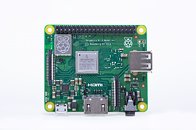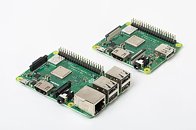Thursday, November 15th 2018
The New Raspberry Pi 3 Model A+ is Here: Smaller, Cheaper, But With Compromises
The original Raspberry Pi showed the world that we could have (almost) a computer for $35. This little prodigy has surprised us over and over again, and their developers have now announced the Raspberry Pi 3 Model A+, which according to them "is about closing things out in style" on the current generation of this miniPC. The new version has shrunk down the previous Model B+ both in size and in price: it is now available for just $25. To accomplish that we'll have to live with certain comprises.
The new model keeps the same CPU, but halves the memory to 512 MB of LPDDR2 SDRAM, the four USB 2.0 ports are reduced to one, and there is no Ehernet port available. The rest of its connectivity options are still there, including the 802.11 ac WiFi or the Bluetooth 4.2 LE support. The new model sits therefore between the even more compact Raspberry Pi Zero W and the Raspberry Pi 3 Model B+ announced in March 2018. As Eben Upton explained on the official announcement, the next Raspberry Pi will be quite different from the current generation: "whatever we do next will of necessity be less of an evolution, because it will need new core silicon, on a new process node, with new memory technology". Until that future model arrives, though, the new and compact version of the Raspberry Pi could be an interesting option for many users.
Source:
Raspberry Pi Foundation
The new model keeps the same CPU, but halves the memory to 512 MB of LPDDR2 SDRAM, the four USB 2.0 ports are reduced to one, and there is no Ehernet port available. The rest of its connectivity options are still there, including the 802.11 ac WiFi or the Bluetooth 4.2 LE support. The new model sits therefore between the even more compact Raspberry Pi Zero W and the Raspberry Pi 3 Model B+ announced in March 2018. As Eben Upton explained on the official announcement, the next Raspberry Pi will be quite different from the current generation: "whatever we do next will of necessity be less of an evolution, because it will need new core silicon, on a new process node, with new memory technology". Until that future model arrives, though, the new and compact version of the Raspberry Pi could be an interesting option for many users.


17 Comments on The New Raspberry Pi 3 Model A+ is Here: Smaller, Cheaper, But With Compromises
While competition already offers onboard eMMC storage, USB3.0, 1-2GB RAM, and real GbE, this piece of crap is still the same old SD-only, USB2.0, old Broadcom chipset, half-a-gig to gig of DDR2, and topped off with fake Gig ethernet over USB (which may cause some issues with third-party distros, just like USB2.0 hub on my OPi Win Plus).
This is basically the same shit, only made cheaper by cutting all peripherals. Not even small enough to compete with $10 IoT boards with better specs.
Sold it a few months later and bought my current OrangePi Win Plus without losing a penny in the process.
Biggest problem is still going to be graphics and video drivers, as they're all proprietary. This is the one common flaw in all these boards.
S905 also has decent support with stable releases based off 4.xx kernel
All with hardware acceleration.
Qualcomm is more expensive (though not as expensive as you think), but I'm sure they will dump their leftover 410 in bulk no problem, otherwise we wouldn't have those cheap-ass chinese phones sporting authentic Qualcomm SoCs. Just an example: a Dragonboard costs 75 green piastres, and an ugly Lenovo K3 knock-off costs 75 american rubles. A phone includes an LCD display, plastic housing, bunch of other parts and is generally harder to make. So, realistically they can make a $50 dev board based on this chip and still make good profit. You may argue that they can't make it happen in UK and have to outsource to China, but they had been doing that since RPi2 days anyways.
Sorry, but it doesn't. The basics might work, but it's not at an acceptable level imho.
Hardware acceleration for? Video playback? Great, but does it support all the codecs? Does the GPU work with full 3D acceleration? I guess not.
It's not about what I think, it's what I know. Also, to work with Qualcomm, you need to order large number of chips, which a lot of businesses can't do. Personally I don't want to touch the 410, but that might be a not so expensive part at least. Do they do video/graphics drivers for Linux though? Not even asking for open source, just working drivers on parity with Android.
The funny thing is, phones are cheap, ARM based boards somehow are not as soon as you glance at Qualcomm, I don't know why.
I'm about to help launch a new development board that won't be super cheap either, but at least we've done our best to provide modern software with 4.18.x, rather than 4.4 or some other old crap. It's a bit of a different idea behind the boards as well, as the target isn't educational use as the RPi. However, as it's from a smaller company, the price isn't that competitive, so we'll see if it works out.
the only issue would be "Made In Korea" instead of "Made In Uk" :laugh:
edit, forgot to add: at last the C2 didn't give me a hard time with a perfectly stable 5V/2.5A power supply, the 3B+ was drawing more even at idle and when working it would show "insufficient current input" logo under Libreelec, and the SOC was heating up ... so much for the new metal heatspreader and better regulation of the SOC (via another dedicated chip) plus in Wlan it was slower on his own AC WLAN than with a USB AC dongle ... :roll:
The only problematic ARM GPU is the old and beat-up Mali 400 MP/MP2. Awhile ago I had a Cubietruck w/ A20 SoC onboard and I had to wait for over a year to get proper H/W acceleration on linux. That one still has issues.